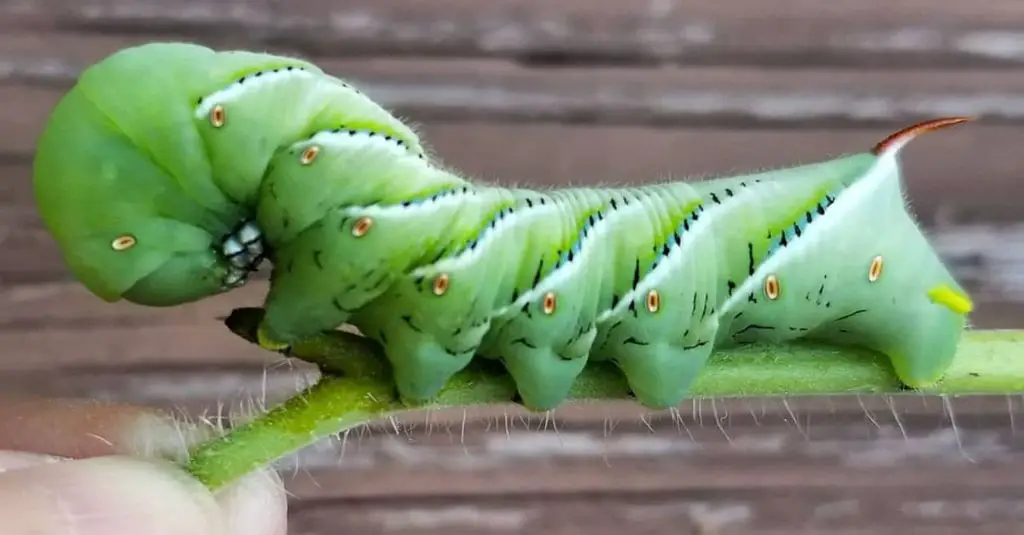Page Contents
Quick Answer
The tomato hornworm (Manduca quinquemaculata) goes through four life stages during its lifespan – egg, larva (caterpillar), pupa (chrysalis), and adult (moth). The total lifespan of a tomato hornworm from egg to death of the adult moth is 30-50 days.
Egg Stage
The lifespan of a tomato hornworm begins when the adult female lays an egg. The eggs are very small, spherical, and pale yellow, about 1.5 mm in diameter. The eggs are laid singly on the undersides of leaves of plants in the Solanaceae family, especially tomato, tobacco, potato and pepper plants.
A single female lays up to 1,000 eggs over 2-3 weeks. The eggs hatch in about 4-7 days. Temperature affects the incubation period, with warmer temperatures shortening the time until hatching.
Larva Stage
After hatching, the larvae or caterpillars immediately start feeding on the leaves of the host plant. The caterpillars go through 5-6 instars or molts, shedding their exoskeleton as they grow. The total larval stage lasts 14-21 days.
In the first 3 instars, the caterpillars are pale green with white and orange stripes running lengthwise along the body. In the last 2 instars, the stripes disappear and the caterpillar becomes plain green with a reddish horn projecting from the rear end, giving rise to the name ‘hornworm’.
The mature caterpillar reaches a length of 4 inches (10 cm). It increases its body mass by a whopping 11,000 times from the freshly hatched larva to the full grown caterpillar. After the final molt, the caterpillar stops eating and purges its gut before entering the next stage.
Pupa Stage
In the pupal or chrysalis stage, the caterpillar transforms into the adult moth. To pupate, the caterpillar chooses a protected spot on the underside of a leaf or on the main stem of the host plant. Here it spins a silk pad and latches on with its claspers.
The larval exoskeleton splits and is shed to reveal the pupa underneath. The pupa is 2-3 cm long, yellowish brown and resembles a thick comma. The pupal stage lasts for another 7-14 days. Inside the pupal case, the larval structures break down as adult structures form. When metamorphosis is complete, the adult moth emerges out of the pupal case.
Adult Moth Stage
The lifespan of the adult tomato hornworm moth is very short, just about 5-10 days. It does not feed during this stage, living off of energy reserves carried over from the larval stage.
The only purpose of the adult moth is reproduction. It has a wingspan of 4.5-7.5 cm. It has greyish-brown front wings with irregular yellowish wavy lines and hind wings with alternating yellow and black bands.
Adult moths become active at dusk and fly at night. Females emit sex pheromones to attract males. After mating, the female repeatedly taps her abdomen on the underside of leaves to lay eggs singly. The adults die soon after reproduction.
Lifespan from Egg to Adult Death
The total lifespan of a tomato hornworm from the egg stage to the end of the adult moth stage is approximately 30-50 days. This includes:
- Egg stage: 4-7 days
- Larval stage: 14-21 days
- Pupa stage: 7-14 days
- Adult moth stage: 5-10 days
Environmental factors like temperature, humidity, host plant health and habitat influence the exact lifespan. Under optimal conditions, a generation from egg to egg can be completed in just 30 days. Cool temperatures extend development time. There are typically 2-3 generations of hornworms per year.
Table of Tomato Hornworm Lifespan by Stage
| Stage | Duration |
|---|---|
| Egg | 4-7 days |
| Larva/Caterpillar | 14-21 days |
| Pupa/Chrysalis | 7-14 days |
| Adult Moth | 5-10 days |
| Total Lifespan | 30-50 days |
Factors Affecting Lifespan
The actual lifespan within the typical duration can be affected by the following factors:
Temperature
Warmer temperatures speed up the development of the hornworm and shorten its total lifespan. Cooler temperatures slow down development and extend the lifespan.
Host Plant Quality
Larvae feeding on healthy, robust host plants with good foliage quality grow faster and transition through the stages quicker. Poor host plant health and inadequate foliage prolong development.
Natural Enemies
Tomato hornworms are kept in check by a wide range of natural predators and parasitoids. Getting attacked by predators like birds, predatory insects and spiders cuts the lifespan short. Being parasitized by insects that lay eggs on the hornworm larvae also shortens the lifespan.
Insecticides
Insecticide applications to control hornworms on crop plants directly reduce lifespans if the larvae ingest or come in contact with the chemicals.
Lifespan in Captivity
Tomato hornworms raised in captivity under controlled conditions with no threats from predators and pesticides can achieve their maximum lifespan potential. By providing them adequate healthy foliage, favorable stable temperatures, and minimal handling stress, they can successfully progress through all four stages and reach close to 50 days.
In contrast, the average lifespan in the wild is much shorter, often only 20-30 days, due to the many hazards and risks the insects face from both biotic and abiotic factors.
Conclusion
The tomato hornworm undergoes complete metamorphosis with four life stages – egg, larva, pupa and adult. Under optimal conditions, the total lifespan from egg to adult death is 30-50 days. However, most hornworms in natural conditions live only 20-30 days due to external mortality factors. Temperature is the main factor influencing rate of development and lifespan duration. Understanding its typical lifespan provides insights into the hornworm’s biology and behavior as a common pest of solanaceous crops.
